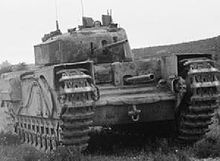| Ordnance QF 3-inch howitzer "3in Howitzer Ordnance Quick Firing" | |
|---|---|
 Mk I Churchill tank with hull-mounted 3-inch howitzer on exercises on Salisbury Plain, January 1942 | |
| Type | Howitzer |
| Place of origin | UK |
| Service history | |
| Used by | British tanks |
| Wars | Second World War |
| Production history | |
| Variants | Mark I, Mark IA |
| Specifications | |
| Mass | 226 lb (103 kg) |
| Length | 78.2 in (1.99 m) |
| Barrel length | 75 in (1.9 m) |
| Calibre | 3 inches (76.2mm) |
| Muzzle velocity | 600 feet per second (180 m/s) |
| Effective firing range | 2,000 yards (1,800 m) |
Ordnance QF 3 inch howitzer was a howitzer fitted to British cruiser and infantry type tanks of the Second World War so they could fire a smoke shell in "close support" of other tanks or infantry. HE shells were also available.
Contents
Earlier British tanks were fitted with a 3.7 in howitzer, based on the QF 3.7-inch mountain howitzer.